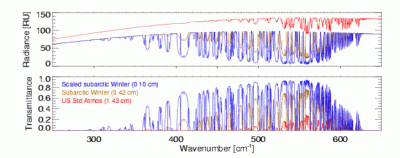Instruments

The relatively recent development of new state-of-the-art infrared interferometers, which measure downwelling radiance in the 17-100 micron and 6-7 micron spectral regions, allow the uncertainties in the radiative transfer models in the far-infrared to be evaluated and addressed. RHUBC will deploy two of these instruments—the ARM AERI-ER and Imperial College TAFTS—at the Atmospheric Radiation Measurement (ARM) user facility site in Barrow, Alaska, in February and March 2007. During this period of time, the amount of water vapor in the vertical column is relatively small (order of 1-2 mm of precipitable water vapor) and the far-infrared band becomes semi-transparent. Furthermore, while the Arctic is often characterized by low overcast conditions, late winter/early spring has a relatively high occurrence of both clear sky scenes and cirrus clouds. The latter is also important for this project, as the radiative impact of cirrus in the far-infrared has not been well studied either due to the previous lack of instrumentation.
In addition to the infrared interferometers, two state-of-the-art millimeter wave radiometers that measure the downwelling emission from the atmosphere at frequencies near the water vapor absorption line of 183 GHz will also be deployed during RHUBC. The University of Colorado/NOAA Ground-based Scanning Radiometer (GSR) and ARM G-band vapor radiometer (GVR) will provide complementary observations of this water vapor absorption line, which will be inverted to provide estimates of precipitable water vapor (PWV). Together, these PWV observations, the atmospheric profile information from frequent radiosonde launches, cloud detection and boundary determination the ARM micropulse lidar (MPL), and the high-spectral-resolution radiance observations from the AERI-ER and TAFTS will provide the data needed to improve our understanding and reduce the uncertainty in modeling the critical far-infrared portion of the spectrum.
Keep up with the Atmospheric Observer
Updates on ARM news, events, and opportunities delivered to your inbox
ARM User Profile
ARM welcomes users from all institutions and nations. A free ARM user account is needed to access ARM data.


















